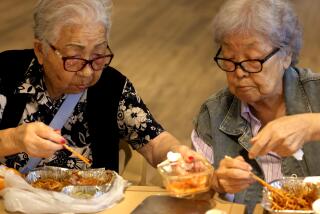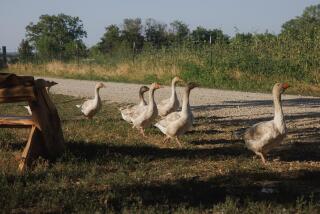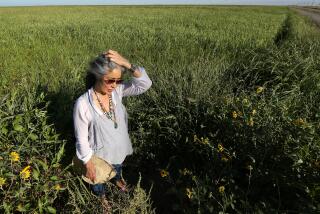Sun Is Setting on Japan’s Small Family Farms
- Share via
OTOYOCHO, Japan — In spring, Mitsuyoshi Oori’s neighbors crowd his mountainside fields and plant rice seedlings into the wet earth. At harvest time, they’re ready with scythes and combines.
The group isn’t just being friendly. It’s part of a corporation formed a few years ago to keep the area’s aging farmers in business--and keep this rural hamlet in southwestern Japan alive.
“When I’m sick I can ask them to plant and harvest--it’s very convenient,” said Oori, 70. “We used to have workers around to pay for help, but those people are gone now.”
All over Japan, farmers are giving up the plow and the hoe. Rice fields are being swallowed by urban sprawl or abandoned by the elderly. Rural areas are emptying out. Japan now produces only 42% of the calories it consumes--down from 79% in 1960.
Behind the decline is a confluence of trends in modern Japan: the rapid aging of the population, the concentration of people and jobs in cities, the shift away from traditional staples like rice.
The changes have spawned visions of a future Japan with a deserted countryside and a precarious food supply, vulnerable to bad weather, war or blockage of trade lines that could cut off shipments.
“We must face the possibility of a serious food shortage in the 21st century,” the agricultural newspaper Nihon Nogyo warned in a recent editorial.
In Tokyo, bureaucrats worried about rural decline and dependency on foreign food are busy rewriting national agriculture guidelines in place since 1961. Draft legislation is due next year.
A government advisory panel has recommended forming more corporations like the one in Otoyocho, letting the market play a greater role in the highly regulated sector and establishing a minimum income for farmers in mountainous regions.
“We need to take bold reforms,” Agriculture Minister Shoichi Nakagawa said in a speech announcing the release of the report in September.
While the government talks reform, Japanese agriculture is undergoing dramatic changes.
The number of Japanese whose main business is farming declined nearly 25% from 1985 to 1995, the government reported last year, and the percentage of elderly among them--many without successors to take over their farms--doubled to 42%.
The amount of farmland under cultivation is dropping as well, propelled by the government’s policy of trimming rice production to cut huge surpluses and by abandonment of land by owners too old or sickly to farm.
Meanwhile, a more affluent Japan is shunning longtime staples like homegrown rice and opting for pizza, burgers and bread--made with foreign ingredients like wheat and beef. Japan is the world’s largest importer of foodstuffs.
At the center of the food security debate is Japan’s heavily regulated and subsidized agricultural sector.
Despite some deregulation and changing tastes, the system is still geared toward planting rice--lots of it. Rice consumption is on a long decline, but that hasn’t stopped producers encouraged by laws and subsidies from growing too much nearly every year.
Japan’s long-protected farmers are also having a hard time competing against cheaper imports coming into the country as markets slowly liberalize. Crucial inputs like machinery and fertilizer are much more expensive in Japan.
Japan also faces another major hurdle: geography.
More than half the country is mountainous, and the whole nation is prone to typhoons, landslides, volcanic eruptions and earthquakes. People barely have room for large houses, never mind horizon-cutting wheat fields or cow pastures.
History has also played a part. Land reform instituted by the U.S. occupation after World War II created a country of smallholders--really small. The average size of Japanese farms is a tiny 3 1/2 acres, meaning they don’t enjoy the efficiencies of larger operations.
Officials acknowledge that the system in place today is outdated.
“Things have changed a lot since 1961,” said Masaki Takamoto, spokesman for the Ministry of Agriculture, Forestry and Fisheries.
Despite the grim landscape, gains are being made. As older farmers give up on their fields, new cooperatives are forming to consolidate smaller plots into more profitable businesses.
Agricultural associations are trying to develop new technologies and boost productivity. And disillusioned urban dwellers and retirees are increasingly returning to rural areas for a simpler life on the farm.
Those changes are slowly filtering through the mountains surrounding Otoyocho, 620 miles southwest of Tokyo on remote Shikoku island. Officials there talk of combining fields and developing new crops.
But the district is more a picture of Japanese agriculture’s past than its future.
Farmers bend over postage-stamp rice paddies terraced into the sides of mountains. More than 60% of farmers in the area are older than 65. Many young people have fled for the bright lights of Osaka or Tokyo.
“Gradually, things are getting harder,” said Oori, who makes ends meet with a pension and odd jobs in the off season. “We can’t live from just farming anymore, so people are heading for the cities.”
One bright spot in Otoyocho is the corporation that helps Oori, the Otoyo Yutori Farm. The group started as a cooperative of about 40 farmers a few years ago and incorporated in 1996. It gets funding from the government and agricultural organizations.
Otoyo Yutori lends a hand in planting and harvest seasons for a fee and provides machinery that smallholders can’t afford to buy themselves. It also has a shop to sell produce in nearby Kochi city and helps distribute the area’s produce to more distant markets.
The corporation is operating in the black and has drawn national attention as a way to invigorate rural areas. But its role in Otoyocho is more a form of life-support for a fading community than a profit-making enterprise.
“If the amount of farming land continues to decrease, we’re afraid nobody will be able to live here,” said Takahiro Mitani, Otoyocho town’s agriculture section chief. “We have to . . . inject some sort of support, even if there’s no economic advantage.”
Cutting-edge agriculture is not a priority for the district’s elderly farmers. Instead, many cling to hopes that middle-aged sons and daughters in the city will retire and come home to carry on the family tradition.
Oori’s son has shown some interest in settling down on his father’s 2 1/4-acre farm. But that won’t be for another 10 years.
Oori said he’s up for the challenge.
“I’ll just have to hang in there till I’m 80,” he said.
More to Read
Sign up for Essential California
The most important California stories and recommendations in your inbox every morning.
You may occasionally receive promotional content from the Los Angeles Times.










